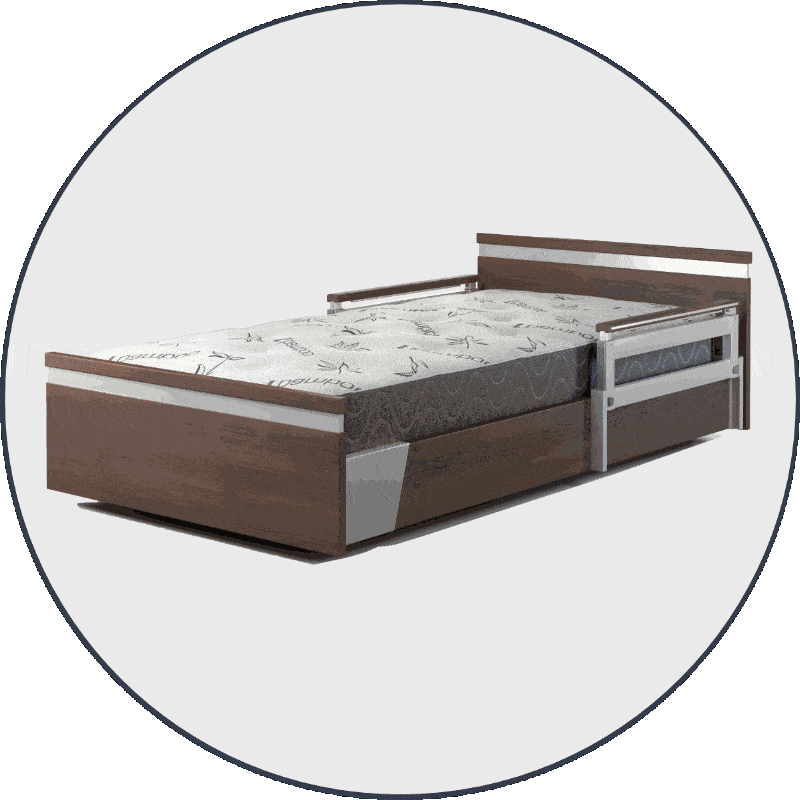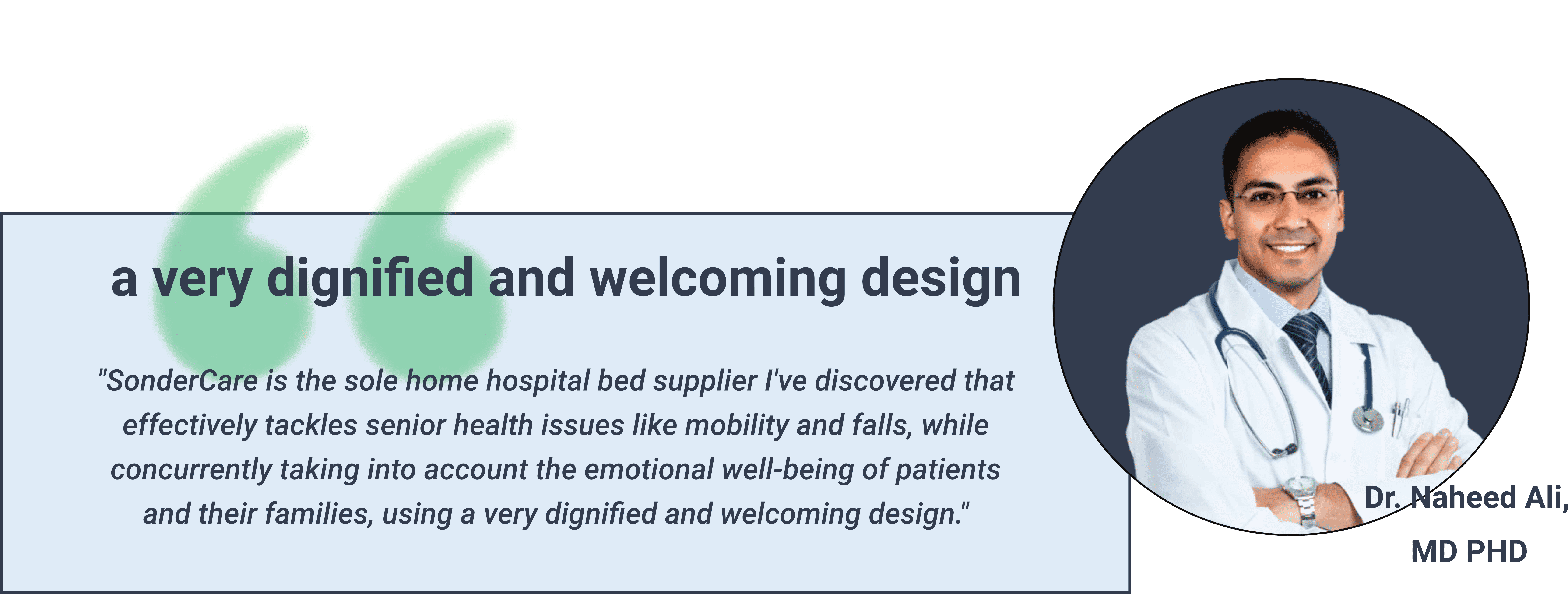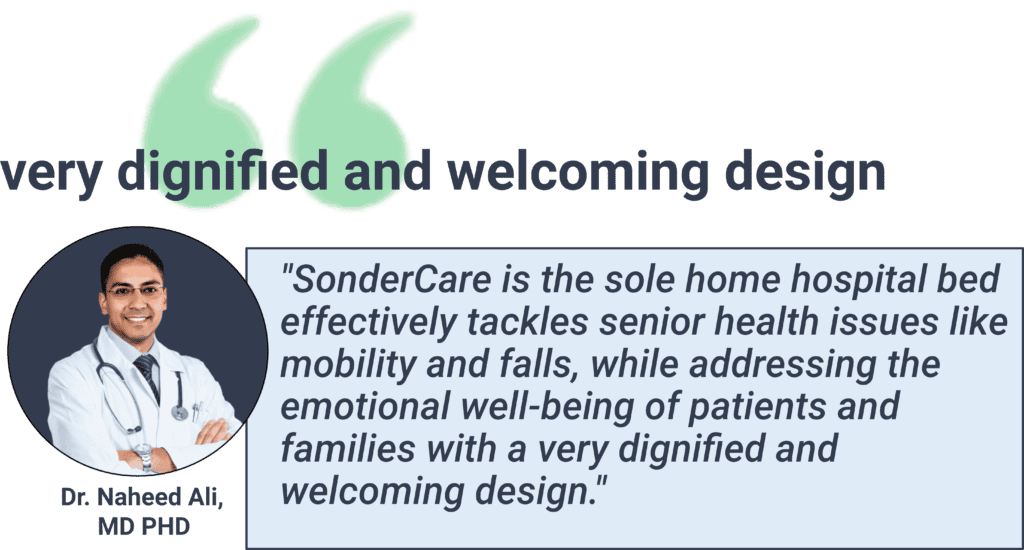Navigating Guillain-Barré Syndrome: Enhancing Safety, Comfort, and Independence with a Home Hospital Bed
A Guillain-Barré Syndrome (GBS) diagnosis can arrive abruptly and significantly alter daily life. For many individuals recovering from GBS and the caregivers supporting them, the weeks and months after hospitalization may be filled with practical challenges, safety concerns, and emotional strain. While no single solution can change the course of a neurological condition, a thoughtfully equipped home environment can meaningfully support comfort and dignity. A premium home care bed for Guillain-Barré—designed to medical standards yet finished with a residential aesthetic—can become a cornerstone of that environment.
This article explains the specific ways a SonderCare bed can support patients managing GBS symptoms and ease the burden on their families, using clear, practical connections between symptoms, daily challenges, and bed features that can make a difference.
The Daily Realities of GBS Home Recovery
GBS commonly produces rapid, symmetrical muscle weakness that in some cases can progress to partial or complete paralysis. In the home setting, this may lead to several predictable challenges:
- Severe difficulty with basic movements (sitting up, turning, transferring), which can impact independence and morale.
- Prolonged immobility may raise the risk of painful pressure injuries (bedsores), a primary concern for anyone seeking information on how to prevent pressure sores when bedridden.
- Respiratory and bulbar (swallowing) muscle weakness in a subset of patients (estimated in about 10–30%1), which can complicate breathing and increase aspiration risk.
- Potential dependence on caregivers for daily tasks, placing heavy physical and emotional demands on families.
Understanding these realities can help families choose equipment that addresses key needs: safety, therapeutic positioning, pressure redistribution, caregiver ergonomics, and preserving the home’s comforting atmosphere.
How an Adjustable Bed for GBS Can Support Healing & Independence
Below we map common GBS needs to the tangible features and potential benefits of a SonderCare adjustable bed for GBS, using a clear Symptom/Need → Challenge → Feature → Benefit structure.
Restoring mobility and fostering independence
Symptom/Need: Severe weakness or paralysis makes even basic transfers difficult.
Challenge: Transferring safely from bed to chair is often a critical factor in determining whether someone can return home.2
Feature: Full Hi‑Lo elevation with precise handset control and infinite positioning.
Benefit: The bed adjusts to an optimal bed height for safe wheelchair transfer (research suggests a range of 51–66 cm)3, allowing individuals to potentially place their feet flat on the floor for a more stable transfer. Intuitive remote controls let patients or caregivers raise the head and achieve a seated position with minimal effort—an early, confidence-building step toward greater autonomy and one of the important mobility aids for GBS recovery. As one patient described their adjustable bed, it was a “godsend” for helping them regain the ability to get out of bed.4
This combination can empower individuals recovering from GBS to participate in their own positioning—helping restore a sense of control during a time of dependence.
Preventing painful and costly pressure injuries
Symptom/Need: Long periods in bed increase risk of pressure ulcers.
Challenge: Sustained pressure, friction, and shearing on bony areas (sacrum, heels) can lead to painful wounds and infections.
Feature: Electric profiling with multi‑section adjustment, Auto‑Regression to reduce sacral shear, and compatibility with specialized pressure‑redistribution mattresses.
Benefit: Frequent, effortless repositioning can reduce continuous pressure on vulnerable areas. Auto‑Regression is designed to minimize shearing forces when the backrest rises. When used with an appropriate alternating pressure or low‑air‑loss mattress, the bed frame becomes part of a system that supports clinical pressure‑injury prevention protocols, helping to protect skin integrity during prolonged immobility.
Supporting respiratory health and safer nutrition
Symptom/Need: Weak breathing and swallowing muscles can increase aspiration and breathing difficulties.
Challenge: Lying flat or poor head elevation can worsen respiratory effort and elevate aspiration risk.
Feature: Precise head‑of‑bed elevation and therapeutic positions such as Cardiac Chair and Comfort/Zero‑Gravity postures.
Benefit: The bed can easily achieve the clinically recommended 30–45° semi‑recumbent position.5 This precise head of bed elevation to prevent aspiration can be crucial for safety, using gravity to aid breathing. More upright, seated positions can also make mealtimes safer and more dignified—supporting both respiratory mechanics and the social benefits of shared meals. While care teams should always advise on safe eating and positioning, the bed’s options provide the flexibility to follow that clinical guidance at home.
Easing the physical burden on cherished caregivers
Symptom/Need: Caregivers must perform physically demanding tasks repeatedly.
Challenge: Repetitive bending, lifting, and awkward postures can lead to caregiver injury and burnout.
Feature: Hi‑Lo elevation to ergonomic working heights, smooth electric adjustments, and quiet motors.
Benefit: Raising the bed to waist height reduces harmful stooping during bathing, dressing, and linen changes. This is key to reducing caregiver back strain when repositioning a patient. Research suggests that adjustable‑height beds can reduce caregiver back strain by roughly 43%6 and may help lower overall back injuries by up to 60%.7 By making daily care safer, the bed provides essential caregiver support for GBS patients’ families, helping to sustain long-term caregiving at home.
Delivering peace of mind through enhanced safety
Symptom/Need: A secure environment that reduces fall and entrapment risks.
Challenge: Sensory changes, weakness, or disorientation can lead to falls or unsafe exits from the bed.
Feature: Integrated, discreet assist rails; ultra‑low height settings; and adherence to IEC 60601‑2‑52 medical safety standards plus certified medical device assurance.8
Benefit: Assist rails, designed to be discreet, offer secure handholds for repositioning without creating an institutional feel. The ultra‑low setting is a significant feature for fall prevention for GBS patient strategies, reducing the risk of injury from an accidental fall. Meeting international medical‑device safety standards can provide families with assurance that the bed is engineered to professional clinical requirements.
A personal touch: one family’s experience
More than a bed: preserving dignity in a healing home
Recovery from GBS is not purely physical—emotional well‑being is also important. Clinical equipment can sometimes feel like a constant reminder of illness. SonderCare’s design aims to address this, creating a hospital bed that doesn’t look like a hospital bed. By functioning as a luxury-style hospital bed, it includes premium finishes, hidden mobility components, and a non‑institutional profile that can blend into a bedroom.
This design choice is intended to support psychological comfort and help maintain a sense of normalcy for family routines and relationships—an often overlooked but vital component of long recovery periods.
White‑glove delivery and ongoing support
A practical detail matters during a crisis: setup. SonderCare’s white‑glove delivery and setup aim to remove another burden from families by ensuring prompt, professional installation and orientation—so families can focus on care rather than logistics. Combined with certified medical‑device manufacturing and durable engineering, this service underscores our commitment to reliability and ease of use throughout the recovery journey.
A foundation for hope and practical care
Guillain‑Barré Syndrome brings uncertainty, but families can take clear, practical steps to shape a safer, more dignified recovery at home. A SonderCare Guillain-Barré Syndrome hospital bed is not a cure; it is a thoughtfully engineered partner—designed to support symptom management, pressure‑injury prevention, respiratory‑safe positioning, and caregiver ergonomics.
If you are a caregiver or patient managing GBS symptoms, consider whether your current home setup supports safe transfers, frequent repositioning, and ergonomic care work. When those elements are missing, a medical‑grade, residentially designed bed often addresses many of them in one comprehensive solution.
Your loved one deserves a recovery environment that balances clinical standards with comfort and dignity. Contact a SonderCare expert to learn how our home hospital beds—backed by certified medical‑device assurance, quiet German‑engineered motors, and white‑glove delivery—can become the foundation of safer, more compassionate care at home.
References
- Approximately 10-30% of adult Guillain-Barré syndrome patients develop respiratory muscle weakness that necessitates ventilatory support.
- The ability of a Guillain-Barré syndrome patient to transfer from a bed to a chair or wheelchair is often considered a significant predictive factor for being discharged to a home or community setting after inpatient rehabilitation.
- A biomechanical study identified that an optimal bed height of between 51 cm and 66 cm results in less perceived difficulty, greater stability, and lower ground reaction forces during bed egress and ingress for patients.
- Patient testimonials from GBS support forums, including one compiled by the GBS|CIDP Foundation International, describe adjustable beds as a “godsend” for enabling them to sit up and get out of bed unassisted.
- Clinical guidelines derived from ICU settings often recommend maintaining the head of the bed (HOB) in a semi-recumbent position, elevated to 30–45 degrees, to improve breathing mechanics and help reduce the risk of aspiration and ventilator-associated pneumonia.
- Some studies analyzing the ergonomic advantages of adjustable beds report a significant reduction in caregiver back strain when compared to the use of fixed-height beds, with one study noting a 43% reduction.
- Data from the National Association for Home Care & Hospice suggests that the use of specialized, adjustable beds may be associated with up to a 60% reduction in caregiver back injuries.
- The design and safety of modern medical beds are guided by international standards, with IEC 60601-2-52 serving as the foundational standard specifying basic safety and performance requirements for medical beds intended for adults. Regulatory bodies like the FDA and MHRA also provide guidance to prevent patient entrapment.















